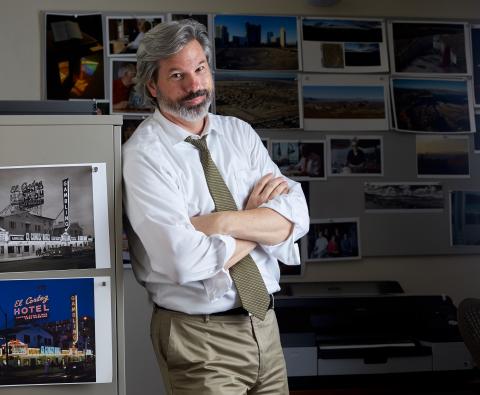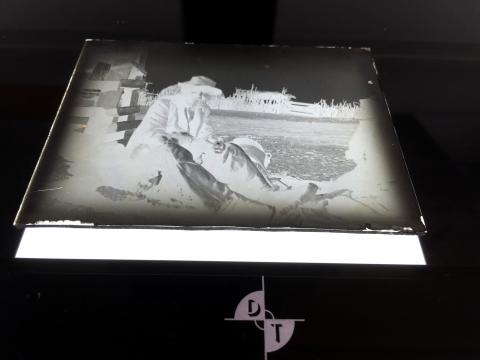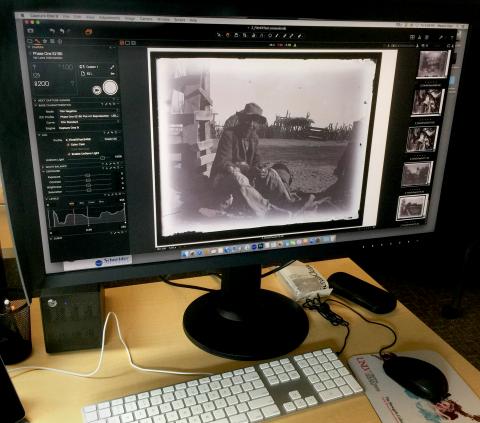
Aaron Mayes, Visual Materials Curator, Special Collections Division
In our Secrets from Special Collections series, UNLV Libraries Special Collections staff members reveal a few lesser-known aspects about the archives and offer up personal insight into research and discovery, sharing answers, based on their own experiences, to six intriguing questions. Here, Aaron Mayes, curator for visual materials, gives us a glimpse into life working among the rare treasures of the library.
1. When you first began working in Special Collections, what was the one item or collection that made your jaw drop, and why? Describe.
Having been on campus for so long (since late 2003) and doing so many projects with the University Libraries and Special Collections in particular, I’ve had the chance to see many of our notable collections. But for me, the glass plate negatives in the Nevada State Parks Collection (PH-00105) are the coolest. Being able to hold the glass negatives depicting life on Kiel Ranch more than 100 years ago is quite a thrill. For those who are unfamiliar, before digital images, there was film, before film, light sensitive emulsion was spread on glass plates. And with the glass being as fragile as glass is, very few samples from our valley’s earliest days have survived.

One of the Kiel Ranch glass plate negatives prior to digitization. (From Nevada State Parks Collection PH-00105)

Phase One camera software showing the positive image of the Kiel Ranch image above.
2. What do you think may be the single most overlooked part of Special Collections?
The expertise of the entire department is such a huge asset for greater Southern Nevada. The community has access to the enormous knowledge base corralled by this group. No matter the question, there is always someone there with an answer or knowledge of which collection or resource to tap. Regional history, gaming, digitization, entertainment, accessioning, collecting, you name it; we’ve got you covered. During a recent visit by a friend of the Library, I watched as each staff member who could join us on a tour took a moment to share their knowledge. I watched this person thoroughly enjoy the visit as each person in Special Collections discussed an aspect of their work or showed off a favorite collection.
3. What is the one question you are most asked about your work, or elements that fall within the scope of your job description?
My job title, curator for visual materials, seems to prompt the most questions. I’m getting better at explaining that my job is basically to grow our repository’s photographic offerings, both qualitatively and quantitatively. I accomplish this by collecting others’ images, producing my own, and helping the digitization side with technical issues.
4. What is the most fascinating or positive aspect of your job? In answering, describe a little about what you do on a daily basis. What is the most difficult aspect of your work? Describe.
To accomplish the goals of this position, I’m faced with a variety of tasks that take me in very different directions. That challenge is the best part of this job. Recently, I had a day that is a good example of this challenge. It consisted of photographing Congregation Ner Tamid for the Southern Nevada Jewish Heritage project, portraits of the son of legendary builder J.A. Tiberti for our recently launched Builders initiative, lunch with a pig farmer to talk about a future project on waste recycling, an impromptu phone conversation with the son of a late photographer who documented the valley from the late 1960s until his death in 2007, and conversations trying to troubleshoot a lens for the digitization lab’s Phase One rapid capture system. My desire to produce work more quickly on all fronts is also a huge challenge. I am a patient person with others, but not with myself.
5. What are you working on right now? How will it contribute to Special Collections?
Immediate impacts are being seen in the Southern Nevada Jewish Heritage Project where my photographs are beginning to flow into the archive and project website. Claytee White and Barbara Tabach have done such great work with the oral histories, while Emily Lapworth, Meghan Gross, and others have pushed the project’s technical side. To add in a bit of visual personality, documentary acumen, and art just grows the project’s quality. Working with Cory Lampert and Emily on digitizing the Culinary Union Collection is exciting as well, as we see how the new Phase One rapid capture system enables them to greatly increase the speed of the digitization process. I will be pleased to watch when their hard work behind the scenes gets a chance to shine as a large and complicated project comes to fruition.
6. What advice would you give students seeking to isolate a topic in Special Collections using primary source materials?
Students have the amazing opportunity utilize the experts found all over the University Libraries and in Special Collections. You cannot replace people like Su Kim Chung or Peter Michel with a search engine and a finding aid. Those tools are great, but the inherent understanding of what collections contain and how to find primary source material is unquantifiable or in student terms: un-Google- able.


